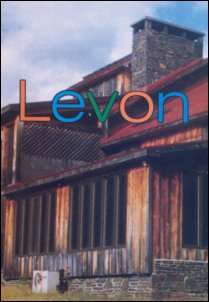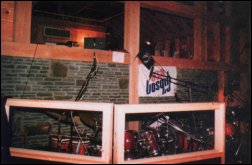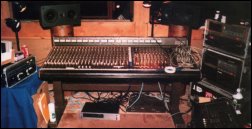
Levon Helm of The Band
Way Back Up in the Woods
by Baker Rorick
This article appeared in Home Recording magazine, October '99. Photos by George Lembesis. The text and the images are copyrighted. Please do not copy or redistribute. Copyright © 1999, 2000 Home Recording, Baker Rorick, George Lembesis.
 Levon Helm |
Levon and the Hawks first came to Woodstock in 1966, to hole up in a rented house and play with Bob Dylan in the basement. In 1968 they reemerged as The Band with Music from Big Pink, recorded in a converted barn at manager Albert Grossman's nearby Bearsville Studios. Their early records are landmarks in the history of American popular music, and The Band was inducted into the Rock & Roll Hall of Fame in 1994.
There's a mystique about The Band, whose three remaining original members--Levon, Rick Danko, and Garth Hudson--are local legends with reputations as notorious recluses, and Levon's barn offers security, independence, and freedom for their continued creativity after some 35 years together.
Levon, born in 1940, had spent half his life on the road when he decided to build. His inspiration was that barn in Bearsville where The Band did much of its early recording.
 Levon's "barn" |
Inside, the main room is maybe 45x30 feet, one end broken up by a number of lofts and balconies hung at different levels, the other end open to the roof four stories above. Capping the roof is a barn cupola with glass skylights and windows all around, to which Levon attributes some of the room's character. "You open those skylights about three inches and all your music, smoke, conversation, whatever, goes right up and goes right on out. Nothin' ever bounces back down in the old microphone. Plain, clear, clean sound. You hear it one time and it's gone, so we don't have any echo to deal with and that gives the room broadcast qualities. We've actually done some radio shows and things from here." The wooden walls and rafters have a warm, golden glow and, despite its size, the barn has an intimate sound and feel. The two ground-floor end walls are of local bluestone, with a fireplace in the south wall, which adjoins Levon's house.
 |
The main floor can be left open for rehearsal or reconfigured with studio gobos for instrument separation and to create isolation booths for vocals and acoustic instruments when recording. There's a baby grand piano and a Hammond organ. A set of organ pipes for Garth Hudson's mighty Wurlitzer are mounted high up on the east wall, and Rick Danko's upright Ampeg Baby Bass leans in a corner.
The barn's drums are a matched pair of Yamaha Recording Custom 20th Anniversary sets. Levon's has a kick with Ludwig Speedking beater, a rack tom and a floor tom. Older Yamaha hardware holds a Sonor snare drum, Zildjian New Beat hi-hats, and a selection of Zildjian and Sabian cymbals.
 |
Aaron Hurwitz is The Band's long-time engineer and co-producer of their last three records, and he also plays keyboards in both Levon's Crowmatix and Rick Danko's band. (The "house" Hammond is his old, modified C-2.) There's a small selection of microphones, "Neumann U-87s and U-67s, Sennheiser 441s, some new Audix 421s and D112s, other by AKG and Audio-Technica," says Aaron, "but we like to just borrow or rent different mics a lot of times." There are mics strung from the rafters, hanging at various levels to capture the sound of the room, either for simple reference or to add to a mix, and mic cables are run down to the basement and garage for echo chambers. When not using a mobile recording truck or rented studio gear for specific projects, most of the "house" gear actually belongs to Aaron.
"For the most part, things go down live, and moments are captured. There's been a lot of music made here in the last 25 years: Levon's solo albums in the '70s and '80s; The Band's last three albums, including last year's Jubilation, with guest appearances by Eric Clapton and John Hiatt; and sessions with the likes of Ringo Starr, Champion Jack DuPree, Keith Richards, Scotty Moore and D.J. Fontana, producer Tom Dowd, to name just a few."
"We like to use it ourselves and have it for other friends so they can use it," says Levon. "We've done about probably 10 or 12 records here in just the past few years, among friends. The goddamn record companies, they can run you crazy about recording, but we got control here. The main thing is, we've got the key."
And it's home. "Yeah," Levon emphasizes, "that's the best: Get up, get dressed, go over and go to work. It's really worked out for us."
